
You scored tickets, muscled through traffic, miracled your way past security, and here you are, finally, inside the Empire Polo Club, exhaling as your eyes open to the cultural juggernaut known as Coachella. Through the crowd of hipsters, hippies, and everyone in between, your gaze locks on a monumental work of art that looks like nothing you have ever seen. At this six-day-over-two-weekends music festival, the visual art grows bigger, brighter, and more audacious with each April’s incarnation.
If you watch the news coverage and social media, you’ll likely see more images of people interacting with massive, colorful works of art than of bands performing onstage. Who could forget the 36-foot-tall astronaut created by the Los Angeles–based collaborative Poetic Kinetics? And how many people found refuge at the shaded and wholly recyclable Pulp Pavilion by L.A.’s Ball-Nogues Studio; marveled at the Transformers-like spider that Christian Ristrow built with massive yellow excavators; and tripped out at Phillip K. Smith III’s mirrored structures that reflected their surroundings in the daytime and bathed them in color at night?
One of the objectives of the properly named Coachella Valley Music and Arts Festival is to give almost 200,000 concert revelers an immersive, visceral visual experience that resonates as brilliantly as the sounds.
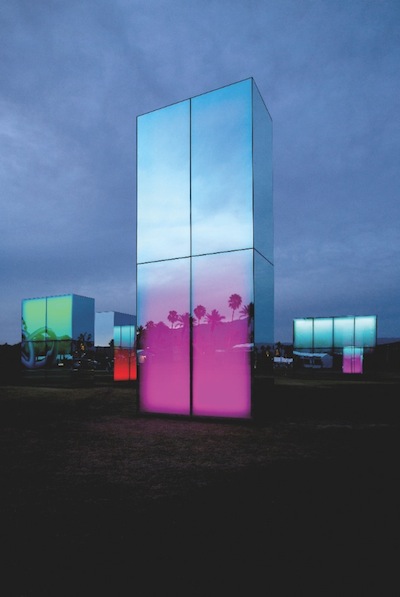
By day, Phillip K. Smith III’s mirror-faced Reflection Field reflected the crowd. By night, colorful LED lights transformed the towers, inviting an immersive, contemplative experience.
Photo by Lance Gerber
“You’re having an intense experience watching your favorite band onstage, and then it ends and you turn your back and there’s another world,” says Smith, the Palm Desert–based artist whose relatively small-scale Lucid Stead installation near Joshua Tree went viral in 2013 and planted the idea for last year’s Reflection Field, which included a two-story structure.
This month, Smith and a mostly new lineup of artists install the biggest and costliest works of art in the festival’s 17-year history.
“It’s a different vibe with different artists,” says Paul Clemente, art director for the festival promoter, Goldenvoice. “We want to grow, explore, and push the limits of what we can do. We’re integrating ideas from different parts of the world, which we haven’t done in the past.”
Clemente spent much of the last year traveling the world, visiting artist studios, and seeing new and legendary installations, including two pioneering earthworks (Robert Smithson’s Spiral Jetty and Michael Heizer’s Double Negative) and 400 acres in Marfa, Texas, where minimalist Donald Judd acquired an entire army base to install his signature concrete box structures along with light works by Dan Flavin. “I went to the Venice Biennale, the Havana Biennial, Art Basel Miami Beach, and London to discover what’s out there,” Clemente says. “It’s been so exciting to have the freedom to go anywhere and see anything I felt I needed to see to figure out where we can go with this.
“This moment, this point in the evolution of our program, has coincided perfectly with and was more than partially inspired by what has happened with Desert X over the last year,” he continues, referring to the exhibition of site-specific artworks curated by Neville Wakefield that will canvas the Coachella Valley in 2017. Clemente joined the Desert X board of directors, which boasts Ed Ruscha, former Palm Springs Art Museum Director Steven Nash, and influential collectors, curators, and philanthropists. “All of these people have been generous with recommendations of artists and connections to curators. I’m very excited to be involved with them.”

Pulp Pavilion offered an iconic meeting place, respite from the sun, and a vantage point for two stages.
In With the New
Coachella ultimately will do for visual artists what it does for so many musicians: elevate their careers so they can take their talent and expression to greater heights.
Smith attests, “Never before had I seen, in three minutes, 1,500 people walk through my installation at night and be bathed in color. Getting to those numbers happens over many years. Here, in six days, you can have 200,000 people and press from all over the world walking through your project.” Photographs of his installation landed on the cover of the Los Angeles Times Calendar section and in thousands of social media posts.
“I really feel like Phil [Smith] is an artist who is going to be doing bigger and better things,” Clemente says, “and we’ll all see his work all over the world 50 years from now.”
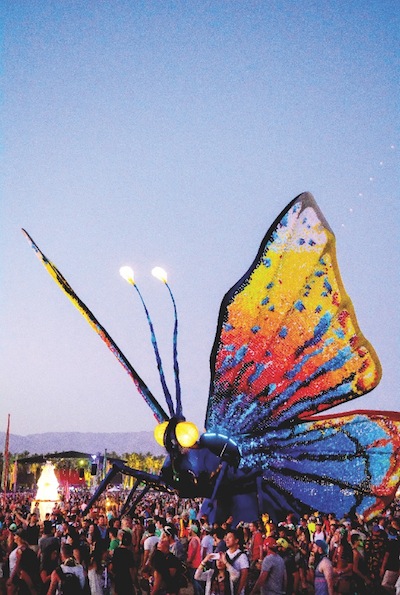
Poetic Kinetics returned in 2015 with Papilio Merraculus, a giant caterpillar that was replaced on Sundays by a butterfly, a metaphor for the transformational rite of passage that is Coachella.
Several artists, including Smith and Do Lab, return this month, while other festival fixtures, most notably the playful and prolific Poetic Kinetics, were omitted.
The new artists include Katrīna Neiburga and Andris Eglītis, who collaborated on the multimedia installation Armpit for the Latvian pavilion at the 2015 Venice Biennale, one of the world’s most important contemporary art events. A monument to everyday creativity, their crudely constructed woodshed structure contained video screens showing Soviet-era “garage men” tinkering with all sorts of machines and gadgets.
“It’s such an incredible sculptural piece from the outside, and it has stuff going on inside,” Clemente explains. “Of all the hundreds of works of art at the Venice Biennale, I was blown away by the Latvian pavilion. And then to be able to contract with them to install a version of that here … I’m super excited. It’s so dynamic. They’ve added interesting geometry. I’ve been working with this team via Skype, and only one of them has been to the United States. It’ll be great.”
Other artists include Alexandre Arrechea, a founding member of the Cuban artist collective Los Carpinteros who represented his country at the 2011Venice Biennale, and the can-do-anything performance collective Lucent Dossier, which has called Burning Man its home away from home.
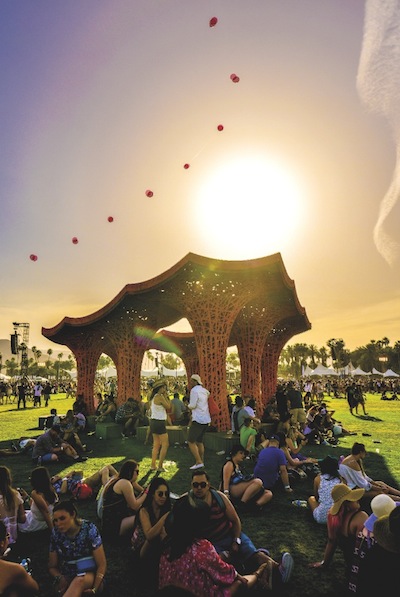
Ball-Nogues created the recyclable Pulp Pavilion by spraying a blend of paper pulp, water, and pigment onto a woven lattice of natural rope. Robert Bose’s Globe Chain of balloons drew the eye to the sky.
“[Goldenvoice] is fully committed to the artists,” Smith says. “There’s zero façade and no bullshit. There’s no ‘Can you do it this way or that way?’ They say, ‘If this is the way that the artist needs it, it’s how it must be.’ They want to create an experience, something no one has ever seen, and make it something they’re proud of, and the art is a big part of that.”
Smith has produced many public art works around the country, but nothing of the scale and intensity of what he’s building this month. He estimates between 70 and 80 people put their hands on Reflection Field during its creation and installation. Again, he has a team of collaborators with expertise in glass, steel, lighting, and engineering that builds his artwork on the polo grounds in 11 days, the same amount of time all of the artists have to install.
He understands that to repeat last year’s success, he must imagine a space where people can disconnect from the action on the stages and in the DJ tents and immerse themselves in a spectacle of light and color. “I want to create another dynamic for when you’re not standing in front of a stage,” says Smith, whose architecture grounding gives him an edge in actualizing large, monumental works. “I want to create a social, spiritual connection that is raw and moves you in a way that life doesn’t move you. It’s challenging and exciting, and it’s a good test for an artist. You need to understand the scale and the environment. Here, you have to get to 50 feet to make an impression. It has to be powerful and memorable.”

In the Date Farmers’ Coachella studio, Armando Lerma and Carlos Ramirez create art about the lives and struggles of the local immigrant community from which they took their collaborative name.
A Dash of Local Color
At first blush, The Date Farmers, a duo of Coachella-based artists Armando Lerma and Carlos Ramirez, might seem like a surprise choice for the festival, considering they work at a more traditional scale. Their paintings, constructions, and installations celebrate and comment on the lives and traditions of the area’s Mexican farmworker community. Lerma’s father owned a date farm where Ramirez once worked as a picker. The two artists met in 1998 when both were selected to show in a local group exhibition.
The Date Farmers’ work exudes a Chicano pop art aesthetic and packs a vocabulary of deep-rooted symbolism to advance their narratives. Their style evokes Jean-Michel Basquiat and Robert Rauschenberg, and their razor-sharp content brings to mind the Mexico-born San Francisco artist and Stanford University professor Enrique Chagoya, who’s known for making paintings and prints that integrate pre-Columbian mythology, Western religious iconography, and U.S. politics and pop culture.
“We’re happy for the opportunity,” Lerma says. “We grew up here, and we always thought that we had a place there. I think it’s time we did something large-scale. At Coachella, it’ll reach a lot of people.”
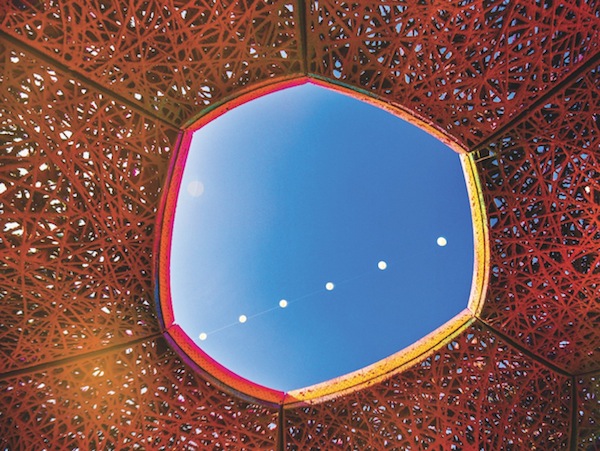
Robert Bose’s Globe Chain of helium-filled balloons appears through the sky space of Ball-Nogues’ Pulp Pavilion.
During last year’s festival, Lerma and Ramirez spearheaded Coachella Walls, a mural project that tells the stories of Mexican farmworkers and laborers and their families who dominate the population. The Date Farmers painted their mural, which commemorates the 1965 grape boycott, on the side of the historic Casa del Trabajador, where farmworkers received services and Cesar Chavez once spent a night.
Lerma says their festival debut has been very helpful in raising their profile as artists. “It’s good that [Goldenvoice is] reaching out. Our work can be a little strong sometimes. Paul [Clemente] has been really supportive. We went back and forth a little bit with some ideas. He let us do our thing.”
Their “thing,” generally speaking, will be a 30-foot painted figurative sculpture that the artists hope will give visitors a better understanding of life in the eastern Coachella Valley. “It’s basically my cousin who died last October,” Lerma says. “He was in prison, and he had cancer, and he was an artist. He was as Coachella as you can get with the gangs and tattoos in the ’80s. His art was about real people. He was telling his story. He was one of my first influences.”
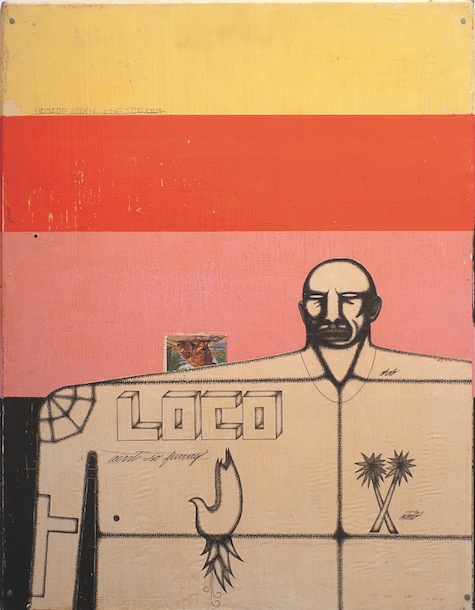
Date Farmers often scavenge discarded materials (below) and cultural images and wrest them together to create new meanings.
They’ll illuminate the sculpture at night and situate it on a platform where people can sit, socialize, and engage with their work. “I want people to feel the strength of the artwork and the traditions of Mexican art,” Lerma says. “People don’t really know what Coachella is. It’s not the festival all year-round.”
The sculpture will be The Date Farmers’ largest creation by far. And Clemente, drawing from his 18-year film industry career in visual and special effects (including work on The Matrix), helped them and the other artists realize their work on the polo field. “My skill set from that world was perfect for this gig,” he says, unfazed by the physical challenges of scale, materials, or fabrication. “They have a lot in common, especially when it comes to building things for the first and only time. When someone says, ‘I want to do this,’ I can assess how to do [it] safely and make it happen.”
In the case of The Date Farmers, he says, “We wanted to work with them because they’re an important part of the creative world of the east valley. They have a great studio. The mayor comes in to talk about stuff. They love it there. I asked them to try to produce the best thing they’ve ever made, and they will.
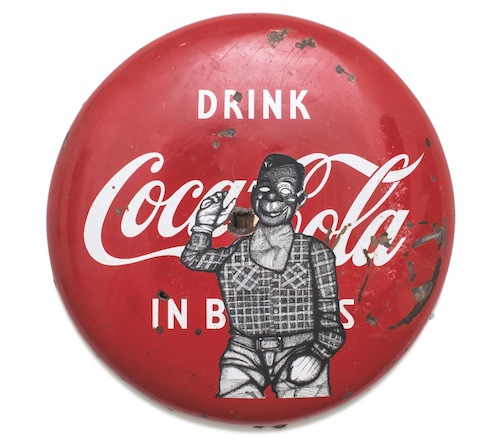
Date Farmers often scavenge discarded materials and cultural images and wrest them together to create new meanings.
“It’s been a great process this year, being able to discuss ideas with [the artists] and help them understand what we need from a piece,” he says. “We’ve been lucky to have access to all the artists we’ve worked with. They all understand that we’re trying to do something different this year. We’ve probably seen a few thousand proposals in the last 10 years. Not any artist can do what we want to do. You need to see this stuff from 1,000 feet away. It all has to fit in with the landscape and palm trees. We know what we need. We know what works.”
It’s impossible to fully appreciate the transformational power of these installations until you’re at the festival. After that, it becomes impossible to imagine Coachella without art.